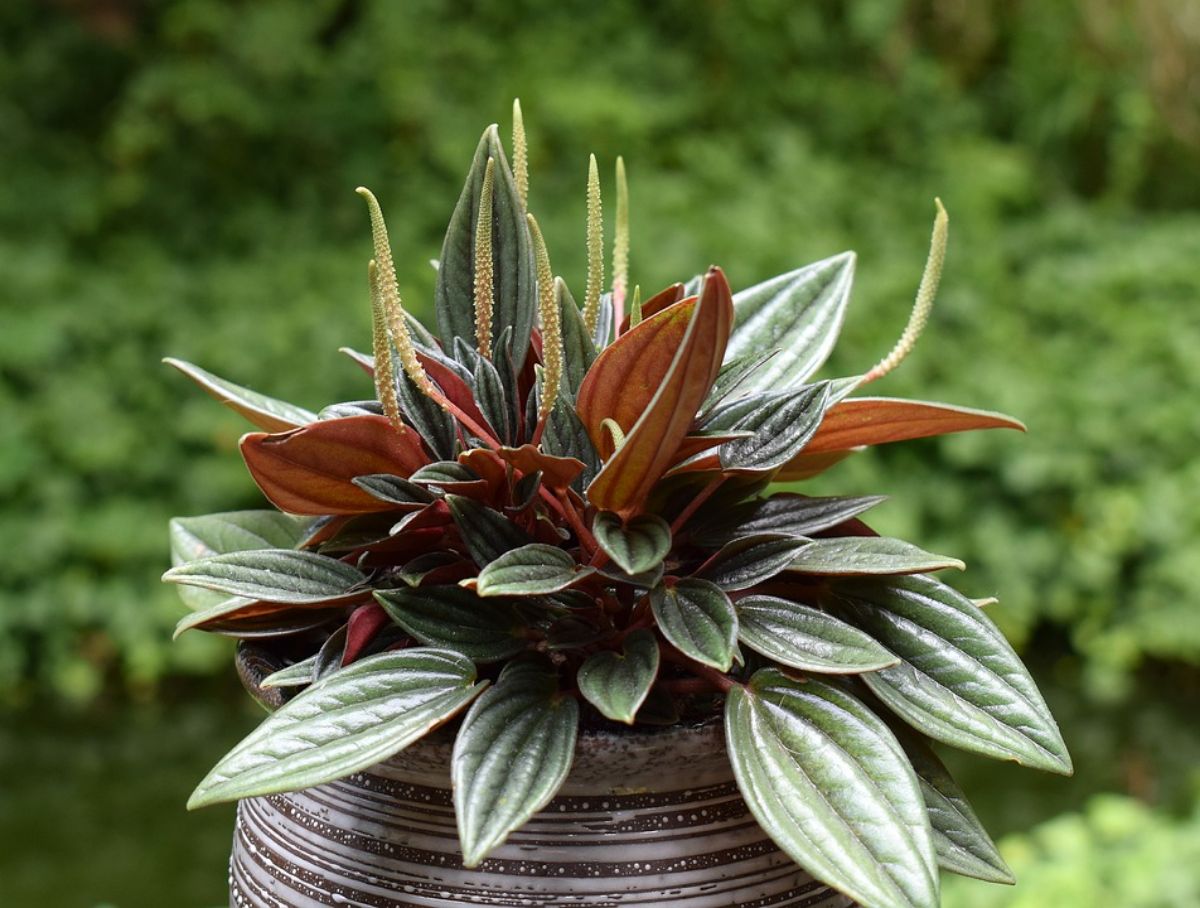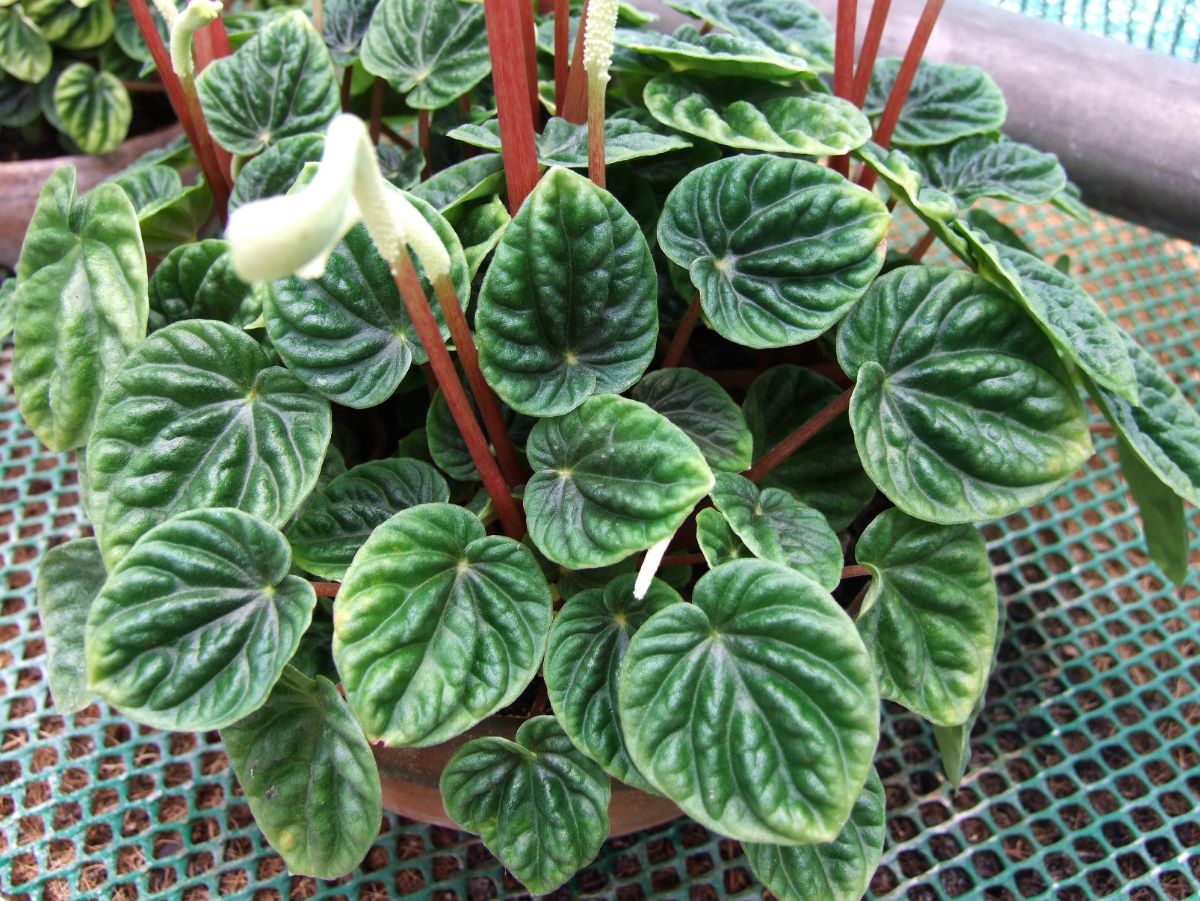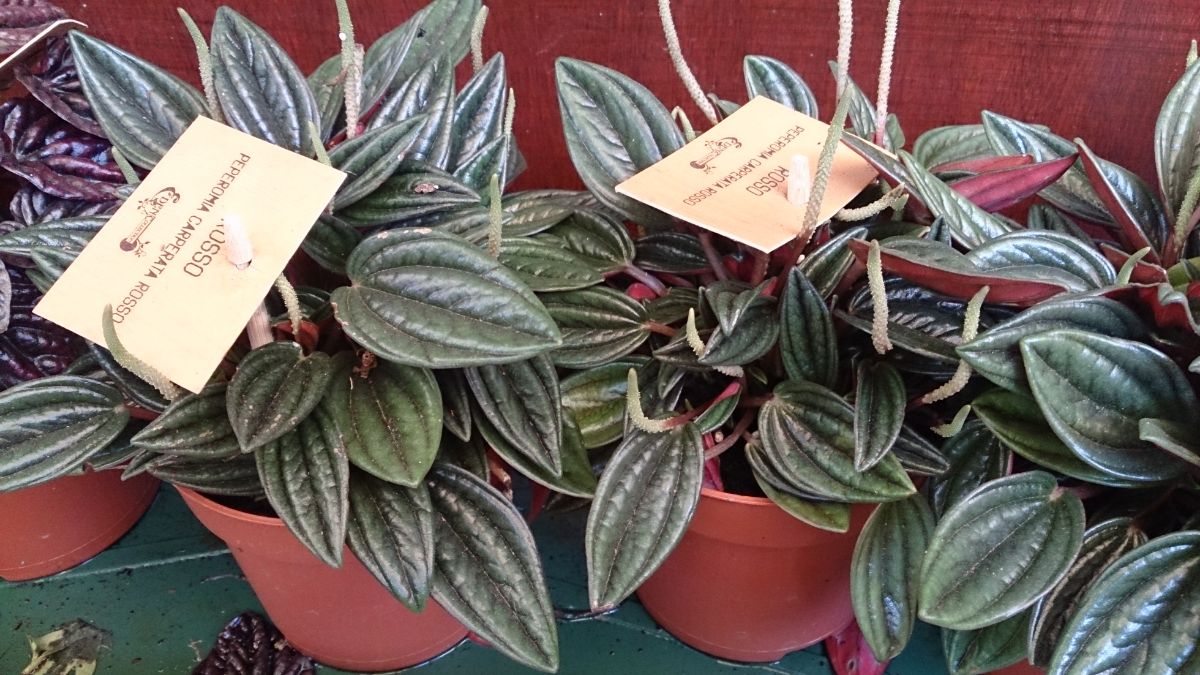
La Peperomia caperata It is a very beautiful plant, so much so that many people decide to buy it and take it home. However, their care is not very easy to say: it does not resist excess water, but it does not live well in dry areas either, and it does not like cold temperatures.
But that doesn't mean it's hard, or not too hard. Next I will tell you everything you need to know so that you can enjoy your peperomia for a long time.
Origin and characteristics

Our protagonist is a herbaceous and perennial plant native to Brazil whose scientific name is Peperomia caperata, although it is popularly known as peperomia or mouse tail. It reaches a height of 20 centimeters, and occupies the same width. The leaves are heart-shaped and have a reddish petiole. The flowers arise from inflorescences between 5 and 8cm long and are white.
Numerous cultivars have been developed: green, red leaves... One of them, the Luna Red, obtained the Award of Merit in Gardening from the Royal Horticultural Society, which was founded in London in 1804.
What are their cares?

If you want to have a copy, we recommend that you provide it with the following care:
Location
Let's think about peperomia. This plant, in its natural habitat, would be in the tropical jungles. But since it is not very big, then the sun's rays do not reach it very much. It would have light, but this would not be direct, but indirect and filtered by other plants.
So, in your home, whether in the garden or indoors, You should place it in a very bright place, but not in direct sunlight.
What does that mean? Take note:
- Indoors: it must be in a room where a lot of natural light enters, which has high ambient humidity (it can be achieved by putting a humidifier or glasses with water around the plant), and away from drafts.
- Exterior: in semi-shade.
Some experts recommend that it always be placed in a south orientation (if you are in the northern hemisphere; north, if you are in the southern hemisphere) because that is where it can grow best.
And what if you don't have as much natural lighting as it requires? In this case, and as an exception, you should know that it can also develop well with artificial light. So even if you live in a dark house, you could have it if you offer adequate artificial light.
Earth
The usual soil for a peperomia is a special substrate for indoor plants. This helps keep the soil moist without damaging the roots. But if you don't want to use that, then go for peat because it has good aeration (if not, you can use perlite or akadama to give it more oxygenation).
Another option is to use compost soil and mix it with some drainage.
Yes, there is difference between planting it in a pot or in the garden. It basically follows the following:
- Pot: humus, gravel and black peat must be mixed in equal parts.
- Garden: the soil must be fertile and have good drainage.
Irrigation

watering a Peperomia caperata It is not abundant, but you should add a small amount. And it is that, in case you do not remember, this plant has both the leaves and the peduncles as if it were a succulent, which implies that it can store water.
Therefore, If you do not see that the soil is dry, or you see the plant turned off, it is better not to water it.
If it's any guide, you should do it 3-4 times a week in the summer, and a little less the rest of the year.
In addition to irrigation, or we could even say apart from it, One of the most important care of peperomia is humidity. In her natural habitat, it would be the tallest plants that would reach the rain before and she would be nourished by the environmental humidity that exists. Therefore, this part is very important (and the reason why your plant may die).
So, if you have one, and you notice that the ambient humidity is not enough (one of the main symptoms will be that the leaves become brittle), then what you should do is group several plants creating groups and put a humidifier in them to activate it several times. hours a day.
Believe it or not, it works. In fact you will begin to notice the smoother and stronger leaves. Of course, remember to rotate the pot so that all the leaves are nourished.
Subscriber
From early spring to late summer with a specific fertilizer for green plants.
You must bear in mind that, if you have just planted it, or it has been less than a year since you have done so, it is not recommended to pay. If you do, use half the product this time. The reason is simple: you have new soil that will have all the nutrients necessary for the plant to grow and develop. But if you provide it with more nutrients, you will be making it grow faster and that can harm its health.
Transplant
Although it is not usual, the caperata peperomia can be transplanted. has to be done always in spring and does not require an exaggerated size change. With a pot a little bigger than where you had it is enough.
If you have this plant in the garden, this will not be necessary, but you should take into account the type of soil it needs.
Multiplication
Playback takes place by seeds in spring. But if you really want to be successful, and move forward faster, there are other ways.
The most common, and with which you can achieve greater success, is through the leaf cuttings.
What you have to do is cut the leaves, always with disinfected and sharp scissors. Make sure to leave 2-3 centimeters of petiole since, otherwise, it will be more complicated than it is.
These leaves should be planted in small pots, with peat soil and you have to make sure that it has a pH between 5,5 and 6,5. Before putting the leaves, the substrate must be moist, to nail the peduncles.
Try not to let the leaves touch the ground, because if this is the case, and you water it, they can rot and it will be more difficult to get them to move forward.
You should keep it moist in the ground for at least 30 days. At that time the pot should be in direct light (in full sun) but avoiding water currents. A little trick is to put a plastic bag or similar creating a kind of greenhouse so that the humidity is maintained and so that the sun filters a little.
When they take root, you will have to wait 30, 60 more days to change it to its new pot, this one is already the definitive one.
Another way to multiply it is through the division of the plant. Although it is not very common to do it this way, it can be done, since when you transplant it you will see that the plant is actually several groups of stems.
These could be divided, being careful to keep both groups rooted, and planted in individual pots, so that you would have larger plants in no time.
Plagues and diseases
We must start from the basis that the Peperomia caperata it is enough resistant to pests and diseases. But that doesn't mean it's untouchable.
In fact, one of the most common, and that will make you get leaves with yellow dots, is the Red spider. You locate this on the underside of the leaf but you will have to use a magnifying glass to detect it.
As for diseases, they can be caused by:
- Excess of water: which will rot its roots and irremediably cause the plant to die. You will know this if the stems start to have black spots on their stems. If you catch it in time, you will only have to change the soil and pot and do not water until you notice that the soil is dry.
- Lack of light: you'll notice this happen when the stems start to get too long. Changing its location will suffice.
- Excess light: When you see that the leaves lose their usual color and luster, the plant will tell you that it has too much direct sun. Again, you will have to move it to another location.
- Cold: As you know, the ideal temperature of the plant is 24 degrees. But if it drops below 15 degrees the plant suffers. And you will notice this when it starts to lose leaves. If that happens, before it's too late you should move it to a warmer location.
Rusticity
It does not resist the cold. Temperature The minimum temperature it can withstand is 15ºC.
What did you think of Peperomia caperata?
It is a wonderful plant and it looks very elegant, it requires care, it is worth having it in your living room or covered terrace, it should not be in the sun. Thank you for your recommendations!!!
Thanks to you, Rafaela!
It is a beautiful mat.!!! Rafaella, would it not be possible to publish a photo of how to reproduce the plant, by cutting the leaf…??
Thank you very much Rafaela for your teachings!!!
Hi Virginia.
We don't have any Rafaela working with us 🙂
But still, thanks for your suggestion. We write it down.
A greeting.